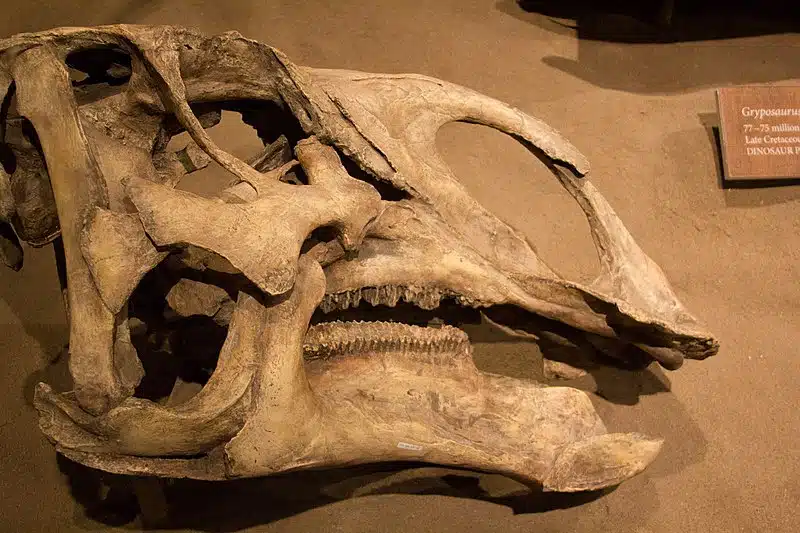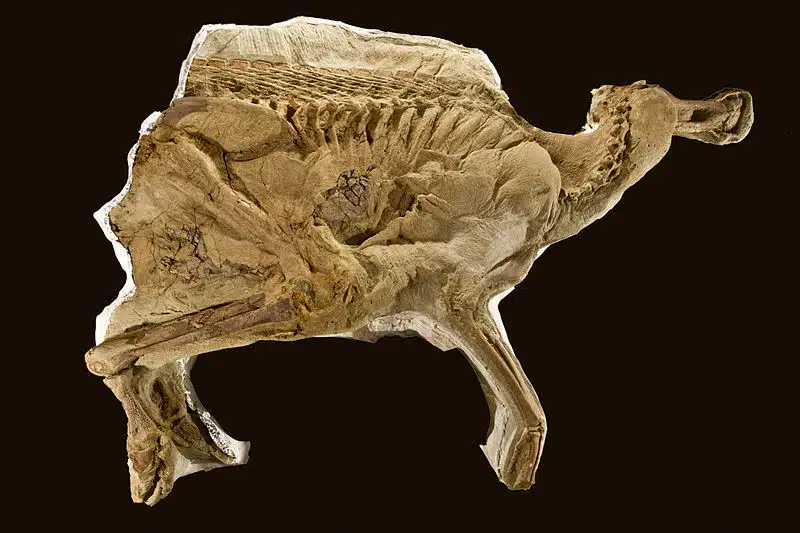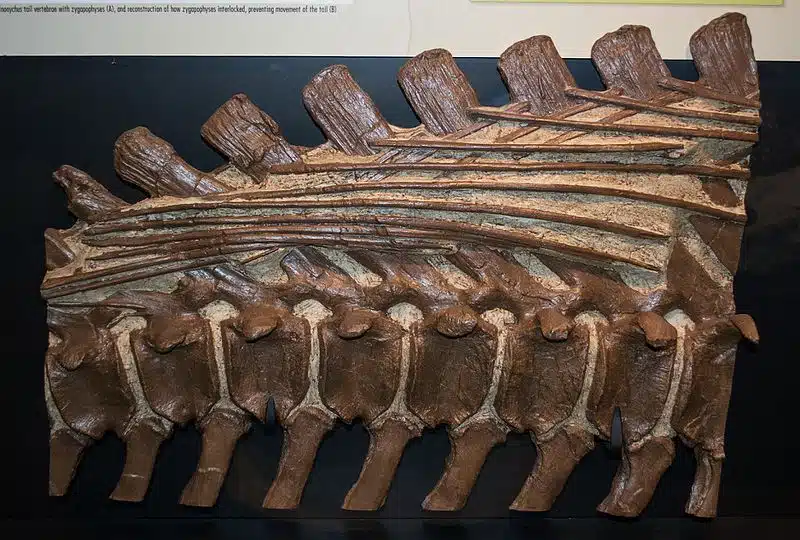Imagine stepping back into the Late Cretaceous Period, a time when massive creatures roamed the Earth. Among these giants was Brachylophosaurus, a fascinating herbivore that offers us a unique glimpse into the world of dinosaurs. As we delve into its story, we’ll uncover the wonders of a bygone era.
Our journey into the past brings us face-to-face with Brachylophosaurus, an intriguing creature whose remains tell a story millions of years old. This dinosaur’s discovery enriches our understanding of the diverse tapestry of life that once flourished on our planet.
Brachylophosaurus Key Facts
| Keyword | Fact |
|---|---|
| Pronunciation | brak-i-LOH-fus-SOR-us |
| Meaning of name | Short-crested Lizard |
| Group | Ornithopoda |
| Type Species | Brachylophosaurus canadensis (syn. B. goodwini) |
| Diet | Herbivore |
| When it Lived | 83.5 to 72.1 MYA |
| Period | Late Cretaceous |
| Epoch | Campanian |
| Length | 30.0 to 36.0 feet |
| Height | Approximately 10.0 feet |
| Weight | 7.7 tons |
| Mobility | Quadrupedal (possibly bipedal) |
| First Discovery | 1936 by Charles Mortram Sternberg |
| Described by | 1953 by Charles Mortram Sternberg |
| Holotype | NMC 8893 |
| Location of first find | Steveville, Alberta |
| Also found in | Montana |
Brachylophosaurus Origins, Taxonomy, and Timeline
The name Brachylophosaurus, derived from Greek, reveals much about this creature: “brachys” meaning short, “lophos” denoting crest, and “sauros” translating to lizard or reptile. The name paints a vivid picture of a dinosaur adorned with a distinctive crest.

Taxonomically, this dino falls under the Ornithopoda, specifically within the Hadrosauridae. The type species, Brachylophosaurus canadensis, stands as the primary representative of its genus. Another species, B. goodwini, was described in 1953, but has since been synonymised with the type species.
The timeline of this magnificent creature spans the Late Cretaceous Period, precisely during the Campanian. This period, 83.5 to 72.1 million years ago, was a time of significant geological and ecological transformations, shaping the environment in which it thrived.
Listen to Pronunciation
To listen to the correct pronunciation of Brachylophosaurus’ name, check out this video.
Discovery & Fossil Evidence
In 1936, the first glimpse into the world of Brachylophosaurus was uncovered by Charles Mortram Sternberg in Steveville, Alberta. This moment marked the beginning of a fascinating journey into understanding this dinosaur.
Later, additional findings in Montana (Judith River Formation), Utah (Wahweap Formation) and Alberta (Oldman Formation, where the holotype was found) added to our knowledge, painting a fuller picture of its existence. These fossils, primarily consisting of bones and partial skeletons, offer invaluable insights into its physical structure and life.
Among the notable specimens, the holotype NMC 8893 stands out, serving as a crucial reference point for further research and study in paleontology.
- Brachylophosaurus skull.
- The mummified specimen “Leonardo” in The Children’s Museum of Indianapolis
- Fossil nicknamed Roberta
- Specimen MOR 940 seen from above
- Skeleton of Brachylophosaurus. On display at the Royal Tyrrell Museum, Alberta.
- Brachylophosaurus canadensis skull from the Late Cretaceous (Campanian) age of Alberta, Canada. Photo by Nick Longrich
- Partial tail with tendons
Brachylophosaurus Size and Description
Brachylophosaurus, a remarkable creature, boasted a unique physique that distinguished it from its contemporaries. Its body was robust, supported by strong limbs, indicating a life on the move. The head featured a distinctive, short crest, true to its name, while its neck was relatively elongated. The vertebrae along its spine supported a well-muscled body leading to a strong tail, which may have been used for balance. It likely had a tough, scaly skin, typical of many dinosaurs, and its locomotion, while not fully understood, may have involved moving on both two and four feet, adapting as needed for feeding or speed.
Size and Weight of Type Species

Estimating the size and weight of Brachylophosaurus poses a challenge due to varying fossil records. However, based on available data, it’s believed that this dinosaur reached considerable lengths and weights. Some estimates suggest it could have measured from 30.0 to 36.0 feet in length. As for its weight, it was likely substantial, possibly weighing several tons, although exact figures are hard to pinpoint. These estimates provide a glimpse into the impressive stature of Brachylophosaurus, a giant of its time.
The Dinosaur in Detail
Delving deeper into Brachylophosaurus, we find unique features that set it apart. Its short crest, unlike the larger, more elaborate crests of some hadrosaurs, may have served a specific yet unclear purpose. Perhaps it played a role in mating displays or social interactions within its herd.
This dino also exhibited adaptability and survival instincts through its physical characteristics. The robust body and strong limbs suggest a life adapted to a diverse range of activities, from feeding on vegetation to possibly evading predators.
Notable specimens, like the holotype NMC 8893, contribute significantly to our understanding of Brachylophosaurus. These fossils provide tangible evidence of its existence, enabling paleontologists to piece together the life and times of this remarkable dinosaur.
Interesting Points about Brachylophosaurus
- Brachylophosaurus had a distinct, short crest on its head, unlike the elaborate crests of other hadrosaurs.
- Its robust physique suggests a versatile lifestyle, potentially involving both bipedal and quadrupedal locomotion.
- The holotype NMC 8893 has been instrumental in shaping our understanding of this dinosaur.
- It lived during a period of significant ecological change, the Late Cretaceous, which likely influenced its evolution and behavior.
- Despite being a herbivore, Brachylophosaurus’s size and strength suggest it was not an easy target for predators.
Brachylophosaurus and its Contemporaries
In the verdant and untamed lands of the Late Cretaceous, where ancient rivers carved their paths and lush forests swayed under a Cretaceous sky, there roamed the Brachylophosaurus.
Among the towering trees and sprawling ferns, Brachylophosaurus shared its realm with Saurolophus, a fellow herbivore and member of the hadrosaur clade. Saurolophus, with its more pronounced, elegant crest, often grazed nearby. These two giants, while similar in diet, managed a delicate balance in coexistence. Perhaps their differing crests were not just ornaments but symbols of diverse social structures or communication methods, unseen but deeply felt in the Cretaceous whispers.
But life in this era was not just a peaceful grazing journey. The shadow of Epichirostenotes, a smaller yet agile theropod, often lurked at the edges of the forests. This cunning predator, though significantly smaller than our gentle Brachylophosaurus, added a sense of urgency and vigilance to the herbivore’s existence. It was a constant reminder that in this ancient world, one’s size did not always guarantee safety.
In this era of giants, another figure loomed large – Gryposaurus. This fellow herbivore, known for its notable arched nasal crest, presented a contrast to Brachylophosaurus’s modest adornment. Gryposaurus, a relative but not a twin of our central dinosaur, carved its own niche in the ecosystem. The diversity of their crests hinted at a rich, communicative life, painting a vibrant picture of dinosaur interactions.
The world of Brachylophosaurus was a tapestry of interwoven stories – a dance of coexistence, competition, and survival. In the shadow of towering conifers and amidst the chorus of ancient rivers, these dinosaurs played out their roles in a long-lost world. Their legacy, etched in stone and bone, reminds us of the ever-changing, ever-evolving saga of life on Earth – a tale of giants, each unique, each an integral thread in the fabric of Cretaceous life.
Brachylophosaurus in its Natural Habitat
Imagining the natural habitat of Brachylophosaurus transports us to a world vastly different from ours. The Late Cretaceous Period was marked by diverse landscapes and climates, possibly ranging from lush forests to open plains. This dinosaur, a herbivore, would have roamed these areas, feeding on the abundant plant life.
In terms of locomotion, the flexible movement capabilities of Brachylophosaurus, potentially walking on both two and four legs, would have been advantageous in navigating its environment. Its diet likely consisted of various plant materials, from leaves to fruits, shaping its role in the ecosystem.
Social behavior is another intriguing aspect. Whether Brachylophosaurus lived in herds or led a more solitary life remains a topic of speculation. However, its physical traits suggest it may have had the capacity for social interactions, possibly even complex herd dynamics.
Frequently Asked Questions
Brachylophosaurus thrived during the Late Cretaceous Period, specifically during the Campanian, roughly 83.5 to 72.1 million years ago.
The first Brachylophosaurus fossil was discovered in 1936 in Steveville, Alberta, by Charles Mortram Sternberg.
As a herbivore, Brachylophosaurus primarily consumed plant material, including leaves and possibly fruits.
Yes, it had a distinctive, short crest on its head, which sets it apart from other hadrosaurs.
It’s believed that Brachylophosaurus could move on both two and four legs, adapting its locomotion to different activities.
Fossils, including the holotype NMC 8893, provide insights into its physical structure, lifestyle, and the environment in which it lived.
Sources
The information in this article is based on various sources, drawing on scientific research, fossil evidence, and expert analysis. The aim is to provide a comprehensive and accurate overview of Brachylophosaurus. However, please be aware that our understanding of dinosaurs and their world is constantly evolving as new discoveries are made.
- https://journals.plos.org/plosone/article?id=10.1371%2Fjournal.pone.0141304
- https://eurekamag.com/research/029/701/029701700.php
- https://www.researchgate.net/publication/233261503_New_information_on_the_cranium_of_Brachylophosaurus_canadensis_Dinosauria_Hadrosauridae_with_a_revision_of_its_phylogenetic_position
- https://www.jstor.org/stable/4523208
This article was last fact checked: Joey Arboleda, 03-10-2024
Featured Image Credit: Nobu Tamura, CC BY-SA 4.0, via Wikimedia Commons







